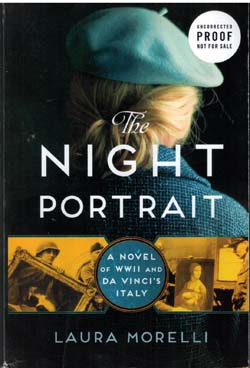 The Night Portrait by Laura Morelli, © 2020 William Morrow, ISBN 9780062-993571; 453 pages, $16.99.
The Night Portrait by Laura Morelli, © 2020 William Morrow, ISBN 9780062-993571; 453 pages, $16.99.
By Laurel Corona

 SAN DIEGO — Many years ago, I lived near a parcel of land that was prepared for a subdivision. A large billboard touted the development as “Another Nice Place to Live.” Every time I went past, I laughed to myself about how much less than a ringing endorsement such a claim was. They meant, “look, we’re doing it again for you!” but the way it came across was more in keeping with an expression that would not be invented for decades: Meh.
SAN DIEGO — Many years ago, I lived near a parcel of land that was prepared for a subdivision. A large billboard touted the development as “Another Nice Place to Live.” Every time I went past, I laughed to myself about how much less than a ringing endorsement such a claim was. They meant, “look, we’re doing it again for you!” but the way it came across was more in keeping with an expression that would not be invented for decades: Meh.
To me that wording implied that it was just one among many options for equally nice places to live. Four decades later, this popped in my mind as I thought of what to say about The Night Portrait, by Laura Morelli. Really, it’s another nice book to read. There’s nothing wrong with it, and in fact I recommend it to anyone interested in its setting or content, but it just doesn’t stand out all that distinctly from other nice books to read.
I couldn’t wait to dive in when I saw the subject matter—a plot weaving the story of the Monument Men ‘s effort to recover art stolen by the Nazis, and one masterpiece, Leonardo da Vinci’s “Lady with an Ermine,” taken from a private collection in occupied Poland. The book sets forth four plot lines, united by the story of the artist (who by the way should consistently have been called Leonardo and never “da Vinci,” which is just the town he was from) and his model for “Lady with an Ermine,” Cecilia Gallerani. The other two main characters live centuries later—Edith, an art historian coerced by the Third Reich into collecting, evaluating, and cataloguing stolen art, and Dominic, a soldier working as part of the Monuments Men trying to track down where “Lady with an Ermine” and other masterpieces had been hidden.
I commend Morelli for her courage in choosing to work with four point-of-view characters, and I can’t think of any way she could have removed any of them and still told such a sweeping story, but the book suffers, in my estimation, from the intricacies inherent in such an approach. Chapters range from two to around ten pages, meaning that often within a few minutes reading time we are bounced from one character to another, and from the fifteenth to the twentieth century and back again. One never has the chance to settle in, to feel involved with the characters, to develop a strong sense of caring, before one is off again someplace else.
The other problem with this approach is that Morelli seems to feel she needs to remind us what’s going on with every change in point of view, so that we hear over and over, for example, how Edith, the art historian, has moral qualms about her work; frets that the paintings may never find their way to museums after the war, or that they will be damaged or destroyed from lack of adequate care; and worries that her elderly father may die before she can get home to Munich. We hear again and again how Cecilia, the young mistress of the Duke of Milan and the subject of “Lady with an Ermine,” is worried about being thrown over by her lover and how she would manage in the world without his support.
The pace of the novel thus becomes a bit like a crosstown taxi ride, experiencing the city in one way when the car is moving, only to be brought to an abrupt stop at every red light. Getting back up to speed is helped by some lovely descriptive writing, and harrowing images of the suffering and devastation of war. It is held back however by the frequency with which the old adage that writers should “show, not tell” is pushed aside in favor of a terser style of writing.
At one of the pivotal moments late in the story, Edith finds herself in a mine, where thousands of works of art have been stored. Morelli offers only that “the sight took Edith’s breath away.” I’d like to have my breath taken away too, but that’s not enough to put me in that cave with Edith. I am just hearing about it in summary later, with all the details removed. It isn’t until five pages later that we are back in the mine with Edith, now horrified to see that precious masterpieces are stored unprotected next to a makeshift latrine. In the interim, we are told again Edith’s concerns about her complicity; hear about how they are collecting, cataloging and sending off the paintings to destinations unknown to her; how the masterpieces might be harmed or lost; and how maybe she could find a way to help them be found again after the war.
Clearly the story is building, as we anticipate that her efforts will lead the Monuments Men to her beloved “Lady with an Ermine” and other treasures by novel’s end. But this is just one example of countless squandered opportunities to draw the reader emotionally into the story. Others may experience The Night Portrait differently, because the plot is indeed compelling, but I found myself on the outside looking in rather than immersed as I read.
*
Laurel Corona, a San Diego-based professor of humanities, is an author and cruise ship lecturer.
.